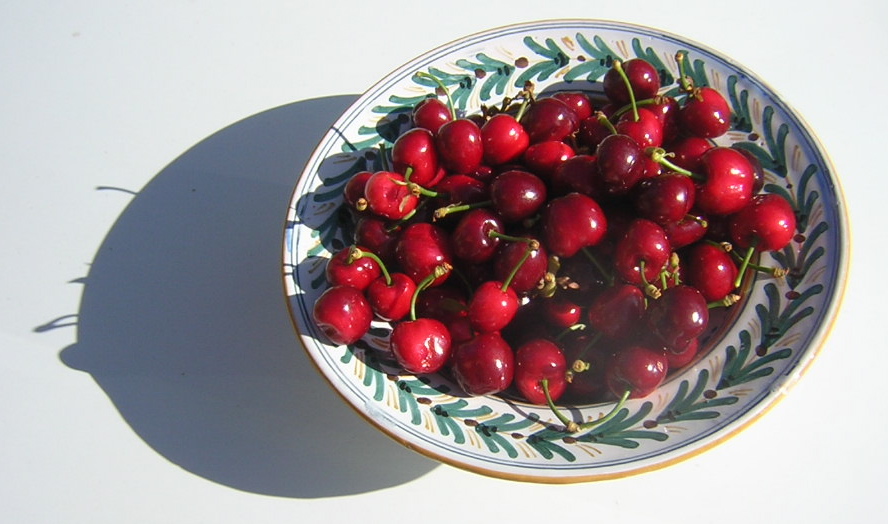a bowl of cherries

Another delicious morning ramble with Julian in 27 degrees - calves brushing up against floodlit banks of red and heads dipping under branches pendulous with darkening fruit. Broom dominates the olefactory sense - yellow pouches spilling their summer holiday smells of pineapple, coconut and honey - and the cats chase a bright green disjointed lizard tail. I steal a cherry. It drips down my chin...
We picked through the details of last night's dinner: A sculptor, an architect, a cook, a musician and an artist gathered in a Bedoin village house eating monkfish tails cooked sublimely with spring vegetables and drinking a light red Sancerre. We are making friends outside the obligatory expat set (who, very kindly, adopt English speaking newcomers on arrival) and we are spending whole evenings discussing art and, of course food, in French!
Aptly settled on rich North African rugs in an ochre room with an excellent collection of paperbacks in view, Julian mentioned the recent discovery that the music of a Berber tribe in Morocco had been found to be 'exactly the same' as the music of an Irish village to which people travelled miles for it's unique folk tradition.
Manuel asks: Can you tell the nationality of a composer in his music? Does it depend on to what degree the music is connected to, or how much it has departed from it's folkloric roots? (Think Bartok, Sibelius, Janacek, Delius...)
Elsewhere, in the riveting discussion on Gail's blog, questions are being posed (inspired by an article about reducing literature to palatable plots for children) about how many 'unique' plots there actually are once the authorial voice has been stripped away. I ask myself also how many 'unique' chord structures there are. After all the blues took route in Mali and Irish Folk music is very close to baroque music.....
I'm chewing on various theories along with my stolen fruit:
The same forms appear over and over again because art, surely, mirrors life. (I also believe the form's presence is felt even through it's absence but that is a whole other subject!): The tension of home (The Base) - Moving away from home (The Journey) - Going back home (The Transformation); Tonic - Dominant-Tonic; I-V-I; The Golden Section. Add or detract to this shape the ingredients which go to mould the authorial voice:
Architecture, Climate, Ceremony, Time, Nature, Religion, Education, Diet, Animals.....
And ponder 'The Voice' as it is used in day to day life (giving sermons, whispering confession, singing in protest, communicating across valleys, gathering herds, sending to sleep, proclaiming love, healing, entertaining, distracting, celebrating...)
...and perhaps it is just possible that, across the seas, the forests and the deserts from each other, with our universal need to sing, to dance, to tell stories and to makes homes, there might be two Romeo and Juliet stories, two folk tunes, two buildings, two painted skies that are, in their essence, 'the same'.
Just being present in this gorgeous late spring moment, I think, however, that my life has nothing to do with journeys or transformations. I think that it takes the simple form of the temptation of a glistening bowl of cherries. Then again, would it not be the bite of the cherry that led me into temptation and off on my journey towards my transformation....?







4 Comments:
a lot to think about ... is the village in Ireland Roundstone?
I have no idea becca, but would love to know more about this story. If you find anything will you pass it on? (ps, changed the blog a bit - was hurried last night and it was a bit rubbish. better now!)
Manuel's question is one that has always interested me.
One always thinks of (or is told) Elgar, for example, as being quintessentially English. Yet how much is inherent in the music and how much a "learnt" response, do you think?
Thiis was a lovely blog post
Post a Comment
<< Home